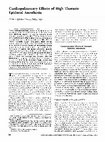Papers by Pedro Alejandro

Techniques in Regional Anesthesia and Pain Management, 1998
Thoracic epidural anesthesia (TEA) is an excellent method for providing segmental anesthesia and ... more Thoracic epidural anesthesia (TEA) is an excellent method for providing segmental anesthesia and analgesia in the thoracic and upper abdominal regions. By causing extensive though incomplete sympathetic denervation, TEA significantly depresses cardiac performance by affecting sinus nodal and atrioventricular conduction function as well as myocardial contractility. TEA also reduces myocardial oxygen consumption, dilates stenotic segments of coronary arteries, reduces infarct size, and speeds up the recovery of stunned myocardium and perhaps provides myocardial protection, which makes it quite useful in the management of patients with severe symptomatic ischemic cardiomyopathy. By providing selective analgesia, TEA improves inspiratory flows and capacities thus yielding a beneficial effect to counteract postoperative atelectasis. Its effects on peak expiratory flows and pressures may, however, affect the effectiveness of coughing. TEA does not correct or improve postoperative diaphragmatic dysfunction. Finally, concerns that thoracic sympathectomy may induce bronchospasm in patients with hyperreactive airways or induce hypoxia by inhibiting hypoxic pulmonary vasoconstriction [HPV] are unfounded.






Uploads
Papers by Pedro Alejandro